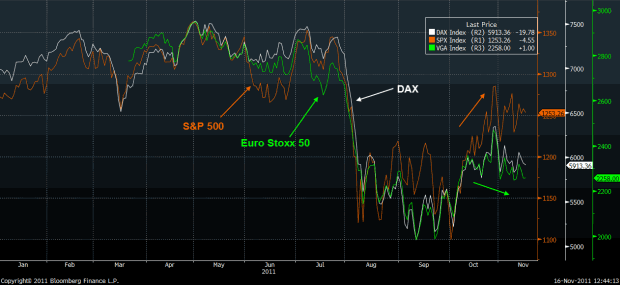U.S. and major European equities have generally moved together as sentiment towards global growth has impacted investor appetite for risk. Below we analyze the German DAX and Euro Stoxx 50 against the S&P 500. Exhibit 1 looks at the price action since the beginning of 2011 and shows how the three have had similar fluctuations. The indices appear to decouple as the debt crisis in Europe intensified. Recent equity moves show that European markets were unable to rally as sharply as the US markets. Additionally, European stocks have turned down significantly while the S&P declined only slightly.
Exhibit 1

The resilience of U.S. stock markets relative to Europe also highlights the diverging growth trajectories. The U.S. economic recovery, though historically weak, has outperformed European GDP growth. Growth in Europe has arguably peaked as recent data show a slowdown in GDP figures (EU GDP grew 1.4% in Q3 from the prior 1.6%). Fears of an EU recession have surfaced as several officials including ECB President Draghi have noted the potential for the region to enter a mild recession. On the other hand, previous concerns of a US recession have subsided as data indicates accelerating growth – last at 2.5% in Q3 from the prior 1.3%.
Exhibit 2 shows the S&P 500 and DAX normalized to 100 on the first trading day of 2011 and highlights the divergence between the US and European markets. The divergence was widest in September when stock markets took a steep drop. It has since narrowed, but remains relatively wide. In our view, we anticipate that this divergence may grow wider due to the intensifying financial stresses and economic slowdown in the euro zone and continued growth in the U.S.
Exhibit 2

Exhibit 1

The resilience of U.S. stock markets relative to Europe also highlights the diverging growth trajectories. The U.S. economic recovery, though historically weak, has outperformed European GDP growth. Growth in Europe has arguably peaked as recent data show a slowdown in GDP figures (EU GDP grew 1.4% in Q3 from the prior 1.6%). Fears of an EU recession have surfaced as several officials including ECB President Draghi have noted the potential for the region to enter a mild recession. On the other hand, previous concerns of a US recession have subsided as data indicates accelerating growth – last at 2.5% in Q3 from the prior 1.3%.
Exhibit 2 shows the S&P 500 and DAX normalized to 100 on the first trading day of 2011 and highlights the divergence between the US and European markets. The divergence was widest in September when stock markets took a steep drop. It has since narrowed, but remains relatively wide. In our view, we anticipate that this divergence may grow wider due to the intensifying financial stresses and economic slowdown in the euro zone and continued growth in the U.S.
Exhibit 2

